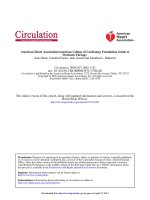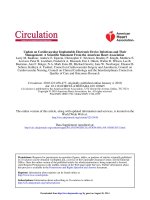Cardiac imaging (radcases), 1e khotailieu y hoc
Bạn đang xem bản rút gọn của tài liệu. Xem và tải ngay bản đầy đủ của tài liệu tại đây (12.8 MB, 225 trang )
MediaCenter.thieme.com
plus e-content online
RadCases
Cardiac Imaging
RadCases
Cardiac Imaging
Edited by
Carlos Santiago Restrepo, MD
Professor of Radiology
Chief of Chest Radiology
Department of Radiology
University of Texas Health Science Center at San Antonio
San Antonio, Texas
Dianna M. E. Bardo, MD
Associate Professor of Radiology
Director of Cardiac Radiology
Oregon Health & Science University
Portland, Oregon
Series Editors
Jonathan Lorenz, MD
Associate Professor of Radiology
Department of Radiology
The University of Chicago
Chicago, Illinois
Hector Ferral, MD
Professor of Radiology
Section Chief, Interventional Radiology
RUSH University Medical Center, Chicago
Chicago, Illinois
Thieme
New York • Stuttgart
Thieme Medical Publishers, Inc.
333 Seventh Ave.
New York, NY 10001
Executive Editor: Timothy Hiscock
Editorial Director: Michael Wachinger
Editorial Assistant: Adriana di Giorgio
International Production Director: Andreas Schabert
Production Editor: Heidi Grauel, Maryland Composition
Vice President, International Marketing and Sales: Cornelia Schulze
Chief Financial Officer: James W. Mitos
President: Brian D. Scanlan
Compositor: MPS Content Services
Printer: Everbest Printing Co.
Library of Congress Cataloging-in-Publication Data
Radcases cardiac imaging / edited by Carlos Santiago Restrepo, Dianna M.E. Bardo.
p. ; cm.
Includes bibliographical references and index.
ISBN 978-1-60406-185-7
1. Heart―Imaging―Case studies. 2. Heart―Diseases―Diagnosis―Case studies. I. Restrepo, Carlos Santiago.
II. Bardo, Dianna M. E.
[DNLM: 1. Heart Diseases―diagnosis―Case Reports. 2. Diagnostic Imagin―methods―Case Reports. WG
141 R312 2010]
RC683.5.I42R33 2010
616.1’20754―dc22
2009031579
Copyright © 2010 by Thieme Medical Publishers, Inc. This book, including all parts thereof, is legally protected by copyright. Any use, exploitation, or commercialization outside the narrow limits set by copyright
legislation without the publisher’s consent is illegal and liable to prosecution. This applies in particular to
photostat reproduction, copying, mimeographing or duplication of any kind, translating, preparation of microfilms, and electronic data processing and storage.
Important note: Medical knowledge is ever-changing. As new research and clinical experience broaden our
knowledge, changes in treatment and drug therapy may be required. The authors and editors of the material
herein have consulted sources believed to be reliable in their efforts to provide information that is complete
and in accord with the standards accepted at the time of publication. However, in view of the possibility
of human error by the authors, editors, or publisher of the work herein or changes in medical knowledge,
neither the authors, editors, nor publisher, nor any other party who has been involved in the preparation of
this work, warrants that the information contained herein is in every respect accurate or complete, and they
are not responsible for any errors or omissions or for the results obtained from use of such information. Readers are encouraged to confirm the information contained herein with other sources. For example, readers are
advised to check the product information sheet included in the package of each drug they plan to administer
to be certain that the information contained in this publication is accurate and that changes have not been
made in the recommended dose or in the contraindications for administration. This recommendation is of
particular importance in connection with new or infrequently used drugs.
Some of the product names, patents, and registered designs referred to in this book are in fact registered
trademarks or proprietary names even though specific reference to this fact is not always made in the text.
Therefore, the appearance of a name without designation as proprietary is not to be construed as a representation by the publisher that it is in the public domain.
Printed in China
978-1-60406-185-7
Dedication
To my husband John, who makes it possible to work with passion and makes the rewards of that work worthwhile.
—Dianna M. E. Bardo
To my parents, Ovidio and Marielena, with all my love. And to my wife, Marta, and my children, Catalina, Juan, and Alejandro,
the joy of my life.
—Carlos Santiago Restrepo
To access additional material or resources available with this e-book, please visit
After completing a short form to verify your e-book
purchase, you will be provided with the instructions and access codes necessary to retrieve
any bonus content.
Series Preface
The ability to assimilate detailed information across the entire spectrum of radiology is the Holy Grail sought by those
preparing for their trip to Louisville. As enthusiastic partners in the Thieme RadCases series who formerly took the
examination, we understand the exhaustion and frustration
shared by residents and the families of residents engaged in
this quest. It has been our observation that despite ongoing
efforts to improve Web-based interactive databases, residents still find themselves searching for material they can review while preparing for the radiology board examinations
and remain frustrated by the fact that only a few printed
guidebooks are available, which are limited in both format
and image quality. Perhaps their greatest source of frustration is the inability to easily locate groups of cases across all
subspecialties of radiology that are organized and tailored
for their immediate study needs. Imagine being able to immediately access groups of high-quality cases to arrange
study sessions, quickly extract and master information, and
prepare for theme-based radiology conferences. Our goal in
creating the RadCases series was to combine the popularity and portability of printed books with the adaptability,
exceptional quality, and interactive features of an electronic
case-based format.
The intent of the printed book is to encourage repeated
priming in the use of critical information by providing a portable group of exceptional core cases that the resident can
master. The best way to determine the format for these cases
was to ask residents from around the country to weigh in.
Overwhelmingly, the residents said that they would prefer a
concise, point-by-point presentation of the Essential Facts of
each case in an easy-to-read, bulleted format. Differentials
are limited to a maximum of three, and the first is always the
actual diagnosis. This approach is easy on exhausted eyes and
provides a quick review of Pearls and Pitfalls as information
is absorbed during repeated study sessions. We worked hard
to choose cases that could be presented well in this format,
recognizing the limitations inherent in reproducing highquality images in print. Unlike other case-based radiology
review books, we removed the guesswork by providing clear
annotations and descriptions for all images. In our opinion,
there is nothing worse than being unable to locate a subtle
finding on a poorly reproduced image even after one knows
the final diagnosis.
The electronic cases expand on the printed book and
provide a comprehensive review of the entire subspecialty.
Thousands of cases are strategically designed to increase the
resident’s knowledge by providing exposure to additional
case examples—from basic to advanced—and by exploring
“Aunt Minnie’s,” unusual diagnoses, and variability within
a single diagnosis. The search engine gives the resident a
fighting chance to find the Holy Grail by creating individualized, daily study lists that are not limited by factors such as
radiology subsection. For example, tailor today’s study list to
cases involving tuberculosis and include cases in every subspecialty and every system of the body. Or study only thoracic cases, including those with links to cardiology, nuclear
medicine, and pediatrics. Or study only musculoskeletal
cases. The choice is yours.
As enthusiastic partners in this project, we started
small and, with the encouragement, talent, and guidance
of Tim Hiscock at Thieme, we have continued to raise the
bar in our effort to assist residents in tackling the daunting task of assimilating massive amounts of information.
We are passionate about continuing this journey, planning to expand the cases in our electronic series, adapt
cases based on direct feedback from residents, and increase the features intended for board review and selfassessment. As the National Board of Medical Examiners
converts the American Board of Radiology examination from
an oral to an electronic format, our series will be the one
best suited to meet the needs of the next generation of overworked and exhausted residents in radiology.
Jonathan Lorenz, MD
Hector Ferral, MD
Chicago, IL
Preface
The opportunity to present a large group of cases to you in
Cardiac Imaging, part of the RadCases series, is a real privilege for us. Working in academic medicine provides us the
ability to teach and learn from residents and fellows as well
as the chance to diagnose a broad range of common and uncommon cardiac diseases, and also further advance cardiac
imaging modalities through research.
The high prevalence of cardiovascular diseases in the
western world, as well as the amazing evolution of imaging
technology available to us makes this book more relevant
today than ever before. It is critical that radiologists are capable of diagnosing cardiovascular diseases.
The power of this cardiac case base is the presentation
of strengths of both CT and MRI through 100 printed and
an additional 150 electronic cases. The 250 cases we have
prepared include not only common presentations, but
uncommon presentations of common problems and examples of cases you must diagnosis immediately to avert
potential disaster. The cases we have written prepare you
for your opportunities to shine when confronted with cardiac cases whether that is on a board examination or in
practice.
We hope this case base review series will be beneficial
for you as you prepare for medical board examinations. This
case base series and the learning experiences during your
training are the foundation for a lifetime of learning you will
experience throughout your career.
Dianna M.E. Bardo, MD
Carlos Santiago Restrepo, MD
Acknowledgments
I wish to acknowledge my colleagues Craig S. Broberg, MD;
Michael D. Shapiro, DO; and Thanjavur Bragadeesh, MB, ChB,
who generously shared their cases for this text and who
teach and inspire excellence in cardiac imaging.
Dianna M. E. Bardo, MD
I want to thank Santiago Martinez, MD (Duke University);
Terry Bauch, MD (The University of Texas HSC, San Antonio);
Jorge Carrillo, MD (Universidad Nacional, Bogota, Colombia);
Ramon Reina, MD (Clinica de Marly, Bogota, Colombia); Julio
Lemos, MD (University of Vermont); and Eric Kimura, MD
(Instituto Nacional de Cardiologia Ignacio Chavez, Mexico),
for their valuable contributions.
Carlos Santiago Restrepo, MD
1
Case 1
A
B
C
■ Clinical Presentation
The electrical system of the heart performs critical functions in synchronized depolarization, resulting in contraction of the
atria and ventricles and ejection of blood into the pulmonary and systemic vascular beds. The important structures and events
in cardiac electrical activity and the usual vascular supply to these structures are described.
2
RadCases Cardiac Imaging
■ Imaging Findings
Components of the electrical conduction system and coronary arteries have been drawn over four-chamber, short-axis, and
two-chamber views of the heart.
A
B
(A) The sinoatrial (SA) node (green dot) is at the superior and posterior margin of the right atrium. Internodal pathways (dotted yellow arrows) span the
SA and the atrioventricular (AV) nodes (red dot). The right (white arrow) and
left (black arrow) bundle branches (orange lines) and Purkinje fibers (black
circle) propagate depolarization through the ventricles. (B) The SA (green
dot) and AV (red dot) nodes are supplied by the SA nodal (small white arrow)
and AV nodal (black arrow) arteries; both are usually branches of the right
■ Differential Diagnosis
• Normal cardiac conduction system: The myocardial
muscle cells and tissue of a specialized conduction system
allow conduction of electrical impulses. Specialized cells in
the conductive tissue depolarize spontaneously.
■ Essential Facts
• Components of the conduction system include the
following:
• The SA node suppresses depolarization of other pacing
cells and is therefore the dominant pacemaker of the
heart. It excites the internodal pathways and the atrial
myocardium.
• Anterior, middle, and posterior internodal tracts are activated by the SA node, propagating the electrical signal
to the AV node, the His bundle, the bundle branches, the
Purkinje network, and the ventricular myocardium.
• The AV node, located at the crux cordis, depolarizes to
assist in propagating conduction of electrical activity to
the His bundle.
• The His bundle and the right and left bundle branches are
organized groups of cells that propagate electrical activity through the ventricles in an organized manner.
• Anterosuperior and posteroinferior divisions of the left
bundle and the Purkinje network increase the speed of
depolarization through the ventricles.
C
coronary artery (open white arrow). Occasionally, the AV nodal branch arises
from the left circumflex artery (white arrow). (C) The left anterior descending artery supplies septal branches that perforate the interventricular septum to supply the bundle branches (orange line). The P and T waves and the
QRS complex of the electrocardiogram (ECG) trace are described below.
• The main components of the ECG trace are the following:
• P wave: The P wave represents the combination of right
atrial activation and the slightly delayed activation of the
left atrium; resulting in atrial systole.
• QRS complex: The electrical representation of ventricular
muscle depolarization; resulting in ventricular systole.
• T wave: Recovery of the ventricular myocardium; ventricular diastole begins as the ventricles relax.
■ Other Imaging Findings
• In patients with arrhythmia, look for thrombus in the left
atrial appendage.
✔ Pearls & ✘ Pitfalls
✔ Myocardial infarction and ischemia can result in
arrhythmia.
✘ Variability of coronary artery dominance results in a
minor inconsistency in the vascular supply of the
conduction system.
3
Case 2
A
B
■ Clinical Presentation
Shortness of breath and chest pain in a 45-year-old man
4
RadCases Cardiac Imaging
■ Imaging Findings
A
(A) Axial T1-weighted and (B) gradient echo (GRE) images at the level of
the heart demonstrate a large mass in the left atrium (white arrow, Fig. A)
B
attached to the interatrial septum and protruding through the mitral valve
into the upper left ventricle.
■ Differential Diagnosis
■ Other Imaging Findings
• Atrial myxoma: A well-delineated, smooth, oval left atrial
mass attached to the interatrial septum is characteristic of
an atrial myxoma. When large enough, an atrial myxoma
may protrude into the left ventricle through the mitral
valve.
• Atrial thrombus: An atrial thrombus more commonly
arises from the posterior or lateral wall of an enlarged left
atrium.
• Sarcoma: An atrial sarcoma typically involves the right
atrium and presents as an irregular infiltrative mass of
soft-tissue density.
• On magnetic resonance imaging (MRI), atrial myxomas
have heterogeneous signal intensity.
• On T1-weighted images, they have low signal intensity.
• On cine GRE images, atrial myxomas exhibit contrast
enhancement after gadolinium injection.
■ Essential Facts
• Myxomas account for one half of all primary cardiac
tumors and are the most common primary cardiac
neoplasms.
• Women are affected more than men. The mean age at
diagnosis is 50 years.
• Large left atrial myxomas commonly cause mitral valve
obstruction (60%).
• Constitutional symptoms (fever, malaise, and weight loss),
cardiac arrhythmias, and embolic manifestations are the
most common clinical complaints.
• Myxomas are attached to the endocardium, and origin
from the fossa ovalis of the interatrial septum is
characteristic.
• Seventy-five percent of myxomas arise in the left atrium
and 20% in the right atrium.
• On computed tomography, > 50% exhibit calcification.
✔ Pearls & ✘ Pitfalls
✔ The majority of atrial myxomas are sporadic, but 7% are
associated with a familial predisposition or manifest as
multicentric myxomas with skin pigmentation, endocrine disorders, and other tumors (Carney complex).
✘ Atrial myxomas and thrombi can have a similar appearance on MRI. Contrast-enhanced MRI can help differentiate between these two conditions because myxomas
exhibit enhancement and thrombi do not.
5
Case 3
A
B
■ Clinical Presentation
A 50-year-old woman presents with a stroke and a heart murmur on physical examination.
6
RadCases Cardiac Imaging
■ Imaging Findings
On cardiac-gated multidetector computed tomography angiography:
A
(A) Axial image at the level of the aortic valve. A well-defined, low-density
polypoid lesion is appreciated on the inferior surface of the aortic valve
leaflets. (B) Coronal image at the level of the aortic valve. A well-defined,
■ Differential Diagnosis
• Papillary fibroelastoma: Contrast-enhanced cardiac-gated
computed tomography (CT) shows a soft-tissue-density
polypoid mass arising from an aortic valve leaflet. The lesion exhibits smooth contour, consistent with the typical
appearance and location of a papillary fibroelastoma.
• Endocarditis vegetation: Infective and noninfective endocarditis can present with a similar appearance as a result
of an aortic valve vegetation. In cases of infective endocarditis, typically more significant damage and dysfunction of
the involved valve are present, and the clinical history and
presentation favor an infectious process.
• Other valvular tumors: In general, valvular tumors other
than papillary fibroelastomas are rare. Myxomas, lipomas,
and hematic cysts have been reported originating from
cardiac valves.
B
low-density polypoid lesion is appreciated on the inferior surface of the
aortic valve leaflets.
• Papillary fibroelastomas can be an incidental finding in
asymptomatic patients evaluated for unrelated conditions, or they can be associated with a distal arterial
embolization (e.g., stroke and transient ischemic attack)
or valvular dysfunction.
■ Other Imaging Findings
• On echocardiography, a papillary fibroelastoma appears
as a small round or oval echogenic polypoid lesion < 2 cm
in diameter with a homogeneous echotexture. It is usually
mobile and has a small stalk attached to the commissure
of a cardiac valve.
✔ Pearls & ✘ Pitfalls
✔ Papillary fibroelastomas are benign, rare gelatinous
■ Essential Facts
• Despite being an uncommon tumor, papillary fibroelastoma is the most common valvular neoplasm. More than
90% are attached to valves.
• The most common location is in the aortic valve (45%),
followed by the mitral valve (36%).
• Papillary fibroelastoma is the third most common benign
cardiac tumor, after myxoma and lipoma.
• Papillary fibroelastomas are usually small (< 20 mm in
diameter), mobile, single lesions.
• The mean age at the time of diagnosis is 60 years.
tumors derived from the endocardium, primarily of
the left-sided cardiac valves, with the potential for
embolization.
✘ These small lesions can be easily overlooked in a
nongated cross-sectional imaging examination.
7
Case 4
B
A
D
C
■ Clinical Presentation
A 57-year-old man presents with a history of recent myocardial infarction with ST wave elevation on electrocardiogram. The
apex was not moving normally on echo, and the ejection fraction was measured at 17%.
8
RadCases Cardiac Imaging
■ Imaging Findings
A
B
C
(A) A left ventricular (LV) outflow tract view shows a rounded shape and
apparent thickening of the LV apex (black arrow). (B) This four-chamber white blood image of the heart shows apparent thickening of the
rounded apex (black arrow). (C,D) Following intravenous administration of
D
gadolinium, delayed images in a four-chamber and a two-chamber view
show rim enhancement of a mass in the apex (white arrows), a thrombus
that has formed on the endocardial surface of the infarcted myocardium.
The thrombus does not enhance (open white arrow).
■ Differential Diagnosis
■ Other Imaging Findings
• LV apical infarction; aneurysm with thrombus formation: The LV apex is rounded and the wall thickness
decreased. Linear enhancement of the subendocardial
surface of the myocardium and no enhancement within
the crescent-shaped thrombus are typical of this diagnosis.
• Hypertrophic cardiomyopathy: Although the apical myocardium appears thickened before gadolinium is given, the
wall is clearly markedly thinned once the endocardium is
defined. Localized hypertrophic cardiomyopathy usually
affects the septal wall.
• Apical cardiac metastasis: The appearance of the apex prior
to gadolinium administration could suggest an infiltrating
metastatic lesion; however, the patient does not have a
known malignancy.
• Look for areas of wall motion abnormality, akinesis,
marked hypokinesis, or aneurysm as a site of thrombus
formation.
• Calcium within or on the surface of the LV thrombus is a
sign of chronicity.
• Calcium may be missed on magnetic resonance imaging
but should be obvious on computed tomography (CT).
■ Essential Facts
• Most thrombi that form in the LV following myocardial
infarction occur within the first 2 weeks, but as early as
48 hours.
• Inflammatory cells infiltrate necrotic myocardium following infarction, inducing platelet and fibrin deposition
on the endocardial surface of the myocardium, encouraging thrombus formation.
• Inflammatory markers such as C-reactive protein may help
to predict in which patients thrombi are more likely to
form.
• Potential embolic complications from LV thrombi portend
a poor prognosis.
✔ Pearls & ✘ Pitfalls
✔ Describe wall motion abnormalities in a systematic manner:
• If the face of a clock is used for reference, 12:00 is the
anterior wall, 3:00 the lateral wall, 6:00 the inferior
wall, and 9:00 the septal wall.
• Between these are regions called the anteroseptal,
inferolateral, inferoseptal, and anteroseptal segments.
✘ On CT, the mixing of contrast with non–contrastenhanced blood is an unusual finding in the LV, but it
may be seen in the right side of the heart.
9
Case 5
A
C
B
■ Clinical Presentation
A 29-year-old man presents with a murmur. What is the high-signal structure adjacent to the spine, parallel to the aorta? Explain how this structure and the abnormal morphology of the heart (Fig. B) are related.
10
RadCases Cardiac Imaging
■ Imaging Findings
A
C
B
(A) In the axial plane, a defect in the septal wall is seen adjacent to the aortic valve (black arrow). In (B) systolic and (C) diastolic images, the defect in
the interventricular septum at the base of the heart (black arrows) is seen in
■ Differential Diagnosis
• Membranous VSD: An obvious defect is seen in the interventricular septum, just below the aortic valve, which
allows the flow of contrast (blood) from left to right.
• Muscular VSD: The muscular interventricular septum is
intact and is normal thickness.
• Aneurysm of the interventricular septum: An interventricular aneurysm is thought to form during the process of spontaneous closure of membranous defects. Such
an aneurysm looks like a windsock, and when completely
closed, it does not allow shunting of blood.
■ Essential Facts
• VSD is the most common congenital heart defect.
• It is one feature of numerous types of congenital heart
disease.
• It is the most common symptomatic congenital heart
defect in neonates.
• The ventricular septum has four segments: inlet, trabecular, outlet, and membranous.
• Defects of the interventricular septum are classified in different ways:
◦ Muscular—entirely surrounded by septal muscle (inlet,
outlet, or trabecular)
◦ Membranous—lies just below the aortic valve; bordered
partially by fibrous tissue inferior to the aortic valve and
medial to the mitral valve. The defect may extend to the
crista, adjacent to the septal leaflet of the tricuspid valve.
◦ Doubly committed, subarterial (combined)—in the outlet
septum and bordered partially by fibrous tissue between
the aortic and pulmonary valves
◦ Inlet—near the mitral valve
a left ventricular (LV) outflow tract view. The more densely enhanced blood
in the left side of the heart flows from the left to the right; a jet of contrastenhanced blood is seen in the right ventricle (white arrows).
◦ Outlet—below the aortic valve
◦ Supracristal—below the pulmonary valve
✔ Pearls & ✘ Pitfalls
✔ Qp:Qs is a ratio that indicates the degree of shunting,
✔
✔
✔
✔
✔
✘
✘
✘
where Qp is the pulmonary resistance and Qs is the
systemic resistance.
Restrictive VSD: Qp:Qs < 1.5/1.0
A high-pressure defect exists between the left and right
ventricles; the shunt is small, and most children are
asymptomatic. A high-frequency holosystolic murmur
is noted.
Moderately restrictive VSD: Qp:Qs 1.5/1.0 to 2.5/1.0
This degree of shunting results in a hemodynamic load
on the LV. Children present with failure to thrive and
congestive heart failure. Holosystolic murmur and apical diastolic rumble are noted.
Nonrestrictive VSD: Qp:Qs > 2.5/1.0
Right ventricle volume overload is seen early, and
progressive pulmonary artery overload becomes symptomatic in early life. Holosystolic murmur and apical
diastolic rumble are noted.
VSD with Qp:Qs > 2.0/1.0 should be closed before pulmonary hypertension becomes irreversible.
Progressive aortic regurgitation may develop with a
restrictive VSD.
View the heart in anatomically correct planes to accurately classify and measure the VSD.
Electrocardiogram-gated computed tomography (CT) or
magnetic resonance imaging (MRI) will show the contrast flow or flow void, respectively, through a VSD.
Quantification of the Qp:Qs is possible with MRI and
echocardiography but is currently not possible with CT.
11
Case 6
A
B
C
■ Clinical Presentation
A 68-year-old man with history of left internal mammary artery (LIMA) coronary artery bypass graft (CABG) to the left anterior
descending (LAD) coronary artery after diagnosis of severe proximal LAD stenosis. He now presents with new angina.
12
RadCases Cardiac Imaging
■ Imaging Findings
(A) In a two-dimensional (2D) planar view, the LIMA bypass graft (small
white arrow) courses from its origin on the left subclavian artery (not
shown) to an end-to-side anastomosis with the mid LAD (large white arrow).
The proximal LAD is patent (black arrows), likely opacified by retrograde
flow. The hyperattenuating foci along the course of the LIMA are surgical
clips (white circle), which are used to close branches of the LIMA.
■ Differential Diagnosis
• Patent LIMA–LAD CABG: The anastomosis of the LIMA
with the LAD is patent, best seen in the 2D view. Retrograde flow into the proximal LAD is a common finding
when the stenotic or occlusive lesion is very proximal.
• Re-established antegrade flow in the LAD: If a CABG is performed to an epicardial coronary artery that does not have
a severe stenosis or occlusion (i.e., the distal myocardium
is not ischemic), the CABG will close because blood flow in
the native artery is maintained.
• Saphenous vein–LAD CABG: Saphenous and other venous
grafts are sewn to the ascending aorta, forming an anastomosis with the LAD and other epicardial coronary arteries
similar to that shown between the LIMA and LAD.
■ Essential Facts
• 64 MDCT has been shown to have a sensitivity, specificity,
and diagnostic accuracy of 100% for the diagnosis of occlusion of CABG.
• Studies show a slight variation in the sensitivity (100–80%)
but agreement in the excellent specificity (91%) and diagnostic accuracy (87%) for determination of flow-limiting
stenosis within a graft vessel.
• MDCT allows sensitive and specific determination of CABG patency and stenosis without the risks of an invasive procedure.
• Serial evaluation of CABG patency is essential, especially in
patients with multiple grafts, as they may be asymptomatic if only one graft is stenosed or occluded.
(B) A three-dimensional surface-rendered view of the heart and the LIMA
graft shows the patent anastomosis with the LAD. (C) Using a different windowing technique, the surgical clips (white circle) are seen. Clips at or near
the anastomosis may make it impossible to make a confident diagnosis of
patency.
• Venous grafts may develop atherosclerotic disease, aneurysms, or pseudoaneurysms.
■ Other Imaging Findings
• Because of their cephalocaudal course, lesser motion
artifacts, and larger luminal caliber, arterial and venous
bypass grafts easier to image and follow on multidetector
CT imaging than are the native epicardial arteries.
• The metal surgical clips used to close branches of bypass
grafts can be beneficial in marking the course of the graft
but detrimental if streak artifact obscures the graft–native
vessel anastomosis.
• Evaluate native epicardial coronary arteries and myocardium for progressive stenosis and evidence of prior infarction, aneurysm, and thrombus.
✔ Pearls & ✘ Pitfalls
✔ Heart rate control with beta-blockers is recommended to
achieve a heart rate between 60 and 65 beats/min.
✔ Use retrospective electrocardiogram (ECG) gating to
calculate left and right ventricle function.
✔ Use prospective ECG gating to conserve radiation dose.
✘ Evaluation of CABG vessels may be limited by slowed
flow through a graft if there is stenosis and potentially by
streak/blooming artifacts from surgical clips and calcium.
13
Case 7
A
B
C
■ Clinical Presentation
Dyspnea on exertion in a 55-year-old man
14
RadCases Cardiac Imaging
■ Imaging Findings
A
B
(A–C) Contrast-enhanced computed tomography of the thorax, with axial
images at three different levels. An abnormal vessel is seen arising from the
C
trunk of the pulmonary artery and continuing into the position of the left
anterior descending coronary artery (LAD).
■ Differential Diagnosis
■ Other Imaging Findings
• Anomalous origin of the left coronary artery from
the pulmonary artery (ALCAPA): The origin of the left
coronary artery from the pulmonary artery, also known
as Bland–White–Garland syndrome, is a rare congenital
anomaly that induces ischemia and hypoperfused myocardium resulting from “steal” phenomenon, in which blood
flow is diverted from the heart to the pulmonary artery.
• Coronary artery fistula: A coronary artery fistula may present as an abnormal-caliber vessel in close relation to the
main pulmonary artery.
• Untreated patients who survive usually exhibit significant
intercoronary collateral circulation with prominent tortuous vessels. The right coronary artery is usually dilated and
tortuous as well.
■ Essential Facts
• ALCAPA is a rare condition seen in 1 in 300,000 live births
and accounts for ~0.25% of all cases of congenital heart
disease.
• The flow in the affected coronary artery is reversed and
is toward the pulmonary artery.
• This is one of the most common causes of myocardial
ischemia and infarction in children, and if not treated, the
mortality rate during the first year of life is ~90%.
• Occasionally, untreated patients with a lesser degree of
ischemia survive until adulthood, and their condition is
diagnosed later in life.
• In the majority of cases, this is an isolated defect, but an
association with other anomalies (e.g., atrial and ventricular septal defects and aortic coarctation) has been
reported.
• The goal of surgical correction is to restore two coronary
artery systems from the aorta.
✔ Pearls & ✘ Pitfalls
✔ The landmark case reported by Drs. Bland, White, and
Garland (Massachusetts General Hospital) in 1933 was
a 3-month-old child with ALCAPA, the son of the prestigious thoracic radiologist Dr. A. O. Hampton.
✔ Other diseases that can present with dilatation of the
coronary arteries are vasculitis (Kawasaki disease, polyarteritis nodosa), scleroderma, Ehlers–Danlos syndrome,
and fistulas.









